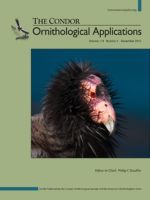This is a delightful book. I suspect that many readers will look quickly at David Tipling's photos and then buy the book either for a coffee table or for an amateur naturalist friend. Both would be fine, but either seriously underestimates the scope and utility of this wide-ranging and beautifully illustrated volume. First the scope: Taylor has done a great job of including everything from common species to occasional visitors, giving useful life-history information for each. This information is broken out into short sections that include an Introduction, with a brief description and field marks; “Distribution, Population and Habitat,” which, while explicitly limited to the British Isles, gives a nod to other areas; “Behavior and Diet,” which is just that, again with an understandable UK focus; “Breeding,” which includes typical clutch sizes, incubation period, and age at fledging; “Movements and Migration,” which links the UK populations to a wider world (perhaps I am being greedy, but some maps might have been nice); and finally a section called “The Future,” which is a discussion of current conservation issues, population trends, and concerns befitting a book sponsored by an environmental organization.
The book is organized taxonomically, beginning with seaducks and working its way through grebes and loons (“divers” in the UK), tubenoses, gannets, phalaropes, and gulls (etc.), ending with alcids. Inevitably, some species get more coverage than others, and the Bibliography stops in early 2013, so it misses Cabot and Nisbet's (2013) excellent New Naturalist Library volume on terns, which is a pity. The majority of references are post-2000, and many are within two years of this book's publication. While the two pages of sources provided are by no means comprehensive, they would certainly be a good place to start for a young grad student or beginning researcher who wants an overview of studies of British seabirds.
In addition to the sections on life history, Taylor has included a number of often amusing and/or thought-provoking sidebars to particular species accounts that range from the origins of local names for the species in question to insights into research or conservation. I also appreciate Taylor's comments on classics in literature, whether Tinbergen's (1953) work on gulls or the lovely children's book Great Northern? by Arthur Ransome (1947). While some of these are flat-out “teasers” (we want more) and some titles (“Mind the Mob,” “Secrets of the Seafarers”) border on the overly cute, ultimately they add to the book's readability. Readability is a key word here. No matter the audience, this is not going to be the sort of book that one reads cover-to-cover in a single sitting, and its size precludes its use as a field guide. Instead, I imagine this book in the kitchen of our field station—easily accessible for happy “dipping” while between tasks out in the colony, or on a side table beside a comfortable couch, where again one wants to get a quick look at information about a particular seabird, only to come up half an hour later having been drawn into the species accounts of four or five others. Make no mistake, this book is not a replacement for, say, the Poyser Monographs (T & AD Poyser), but it isn't intended to be. One should regard it instead as a nicely written introduction with a conservation focus and beautiful photographs.
Now, the photographs: Tipling has done a really remarkable job of capturing a wide range of poses and actions. Every species, including accidentals, gets at least one stunning image, and some get many more. Again, this book is not intended as a field guide, though I can imagine taking a quick look within it to confirm an identification, but Tipling has somehow captured the spirit of the bird time and time again. Field marks are obvious, and seeing the birds in more-or-less typical situations or habitats would aid in recognizing a particular species. It would have been nice if he had given us more images of juvenile birds—the emphasis is very much on breeding adults—but we can be very happy with what we have. In summary, this book belongs in the libraries of lovers of seabirds well beyond the shores of the United Kingdom, and it would be a delightful present for that picky bird-enthusiast who wants more than glamor shots of their favorite bird.






